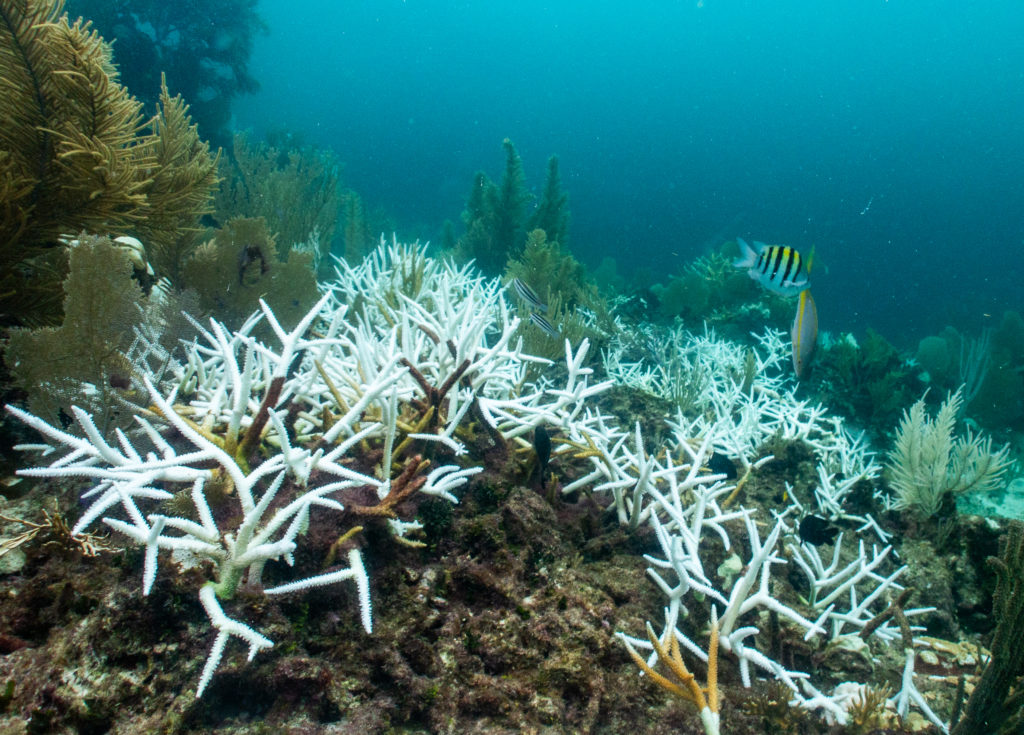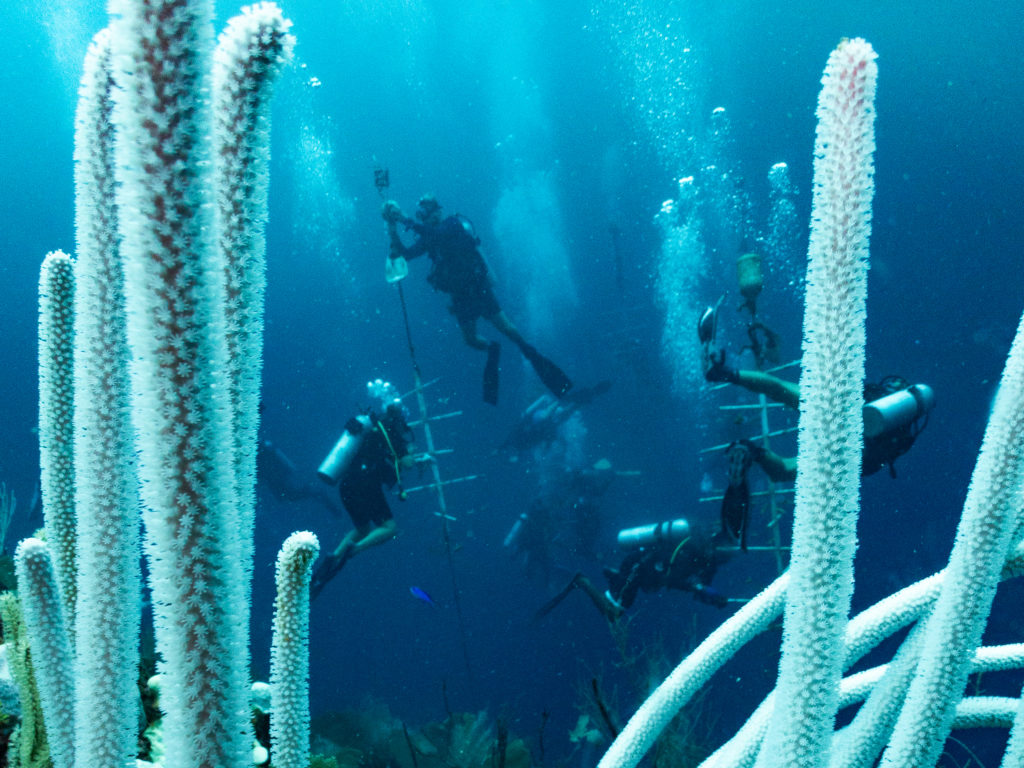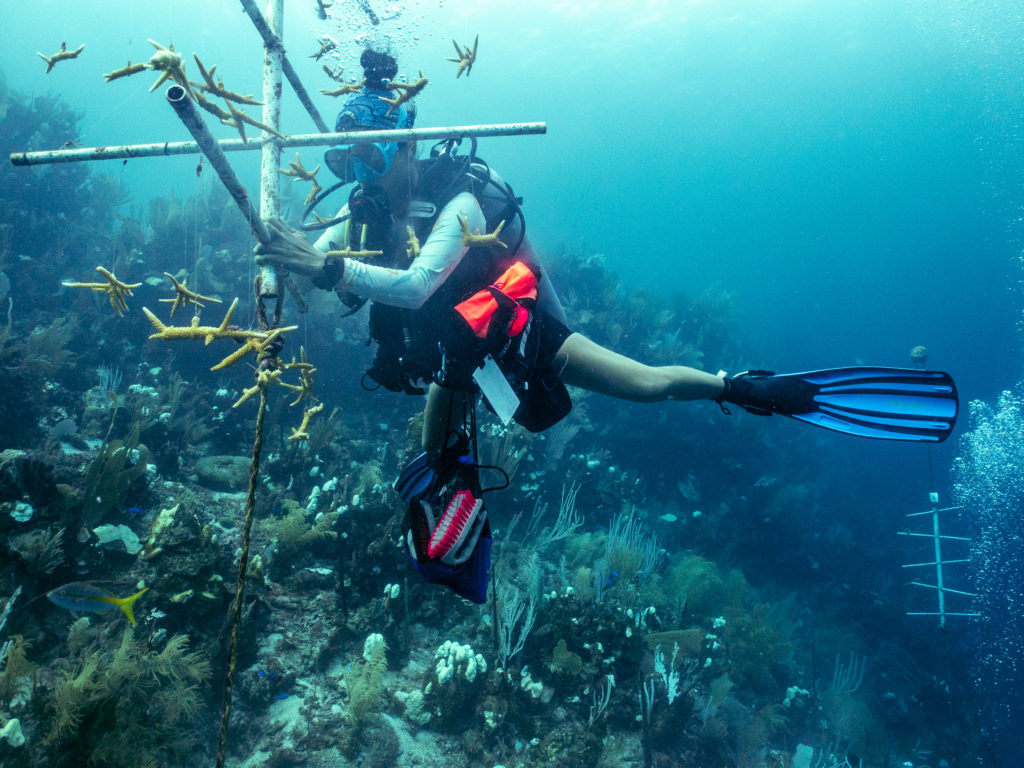Climate change is already pushing Honduran reefs to their limits.
Text and photography: Sierra Garcia
In 30 years of observing the reefs of the Honduran Caribbean, originally as a curious child and now as a marine scientist, Claudia Guerrero had never seen the corals in such bad shape as they looked this October. From the Bay Islands to the northern coast, the hard corals—the same ones that build hundreds of kilometers of reefs and protect the shorelines they surround—had turned ghostly white.
“You feel powerless,” she told me in a video call. Guerrero is the Honduras coordinator for the organization Healthy Reefs for Healthy People, which monitors the health of the entire Mesoamerican reef system (which also includes Mexico, Belize and Guatemala). “You really can’t do anything except document it and spread the word… but I don’t know if there’s a solution in the short or medium-term,” she said.
The recent whitening (or “bleaching”) of corals is a direct consequence of stress from months of high temperatures in the Caribbean Sea. Corals, which are living animals despite bearing passing resemblance to colorful rocks, can withstand heat only up to a certain threshold. After crossing that point, they become “bleached,” a critical state they can recover from if conditions improve, but which can also result in the death of entire reefs if the ocean’s temperature doesn’t drop in time. Guerrero compares these bleached corals to ‘zombies’.
A legacy marked by challenges
Coral reefs are famous for their brilliant colors and the diversity of marine life they support. However, their importance goes far beyond their aesthetic and scientific value. Live corals form the foundation for both Caribbean fisheries and tourism. They offer coastal protection from hurricanes, unparalleled by human invention, by decreasing the strength of waves up to 97% before they reach the shore. If corals die, their remains can continue protecting the coast for decades, but become less and less effective as they’re worn down over time.

“It’s really sad, as a community of divers, to see the future of the reef change in this way,” says Juan Castro Atunez, a scuba instructor from Roatán. “We are seeing how climate change is affecting the reef…and it may affect our tourism.”
While divers and scientists wait anxiously to see how many of the corals will survive, several organizations continue efforts to improve the prospects for Honduran reefs for the future. One of them is the Roatan Marine Park (RMP), a non-profit with several programs to increase the resilience of Roatan’s coral reef. Their solutions include strategies never tried before in the country, such as mixing the eggs and sperm of individual coral colonies that appear more resilient to produce a stronger new generation.
“We’re sort of speeding up or assisting a process that occurs normally that usually takes a really, really long time, but we’re doing it in a sort of shorter term,” explained Andrea Godoy Mendoza, RMP’s research programs manager.
But this process depends on finding corals resistant not only to the threats of ocean heat, but also to deadly diseases that have devastated the populations of dozens of important species. From there, scientists have to capture the eggs and sperm of those resilient corals during one of the few nights all year when they reproduce, an event that can be difficult to predict precisely and that often lasts only a few minutes.
Meanwhile, there is very little that can be done at a local, or even national, level to prevent the sea from warming in the coming years and decades. It is estimated that the strictest international agreements to stop global warming would save between 10-30% of the world’s coral reefs, but that further warming would result in the extinction of virtually all coral reefs.
“We were shocked to observe the undeniable effects of global warming on our beloved ecosystems,” wrote Godoy Mendoza in an Instagram post on October 29. “We did not even need to get in the water to confirm these reports [of coral bleaching], as white specks all over the reefs were clearly visible from the boat.”
In contrast, on the stormy day when I visited the neighboring island of Utila, the surface water was so cloudy that no feature of the reef below was visible. I descended several meters before white shapes emerged, which when approached revealed themselves as the corals: hard and soft, shaped like fans and brains and lettuce heads, but shiny white from the shallowest reef to at least 25 meters deep.
It was late October, and I was there to see the coral nursery, one of at least seven in the country (all in the Bay Islands). In these nurseries, the fragments dangle from simple structures made of plastic tubing suspended over the shallow reef, where divers care for the coral cuttings like underwater gardeners. The project in Utila has been growing staghorn corals for five years, and around it there were thickets of corals planted onto the reef that had started as fragments the size of a finger in that same nursery. I noticed that many of those colonies were bone-white, but still alive.
Raising coral fragments from colonies with some natural resistance to disease and heat is in many ways an easier strategy than assisted sexual reproduction. There’s not much technical equipment required, and the nurseries can operate throughout the year. But this method only produces clones of existing colonies, and the nurseries need regular maintenance.
I visited the Utila nursery accompanied by 14 other divers, most of them young and foreign, who were volunteering that afternoon to clean the nursery of algae under the supervision of professional diver Laura Olarte Bu.

“I always tell them, ‘This is the time we have to act,’” Olarte Bu told me, dismay apparent in her voice. “If we don’t do it now, we won’t have anything later.”
But Valeria Valladares, who has been in charge of managing the nursery in Utila since the spring with the NGO Bay Islands Conservation Association, says there are challenges in involving people long-term to help maintain the nursery. Funding for projects like coral nurseries typically does not include compensation for local people who would like to support the programs with their time, let alone address the barriers that exist to training as a scuba diver to begin with.
“When involving local people you have to take into account their time. Most people don’t have the time to volunteer,” Valladares told me after spending the entire afternoon at the coral nursery.
Who can save the reef?
Although the Bay Islands have the most eyewitnesses to the mass bleaching event, the northern coast of Honduras has not been spared either. Tela Bay has been especially impacted, with more than half of the corals dying in some sites, according to several sources, although many of the most endangered species in the region are still alive and healthy.
“This information is quite sensitive because there are many people who depend on the reef,” says Guerrero. “Not all of us like to admit that this is happening, but it is a reality.”
The “bleaching” of the Honduran reefs, as in the entire Caribbean, was predictable. Scientists have warned for decades that global warming is an existential threat to coral reefs, which require such a specific range of temperatures that an increase of just a few degrees can kill them. And before summer began, the United States’ leading climate and ocean agencies predicted that 2023 would be an especially hot year globally. But the record heat in the Caribbean Sea turned out even worse than the scientific warnings.

Many reefs in both Tela and the Bay Islands have varied levels of government protections, like marine refuges and national parks. But those legal designations, which most often limit fishing and development, receive little funding for enforcement. In the meantime, organizations like the Coral Reef Alliance say that local and regional measures like sustainable fisheries and good water quality, play an important role in strengthening reefs amidst the threat of climate change.
In this respect, corals are similar to people: a reef that is healthy in other aspects might resist the threat of hotter seas better than corals that are already weakened by polluted waters or depleted fish populations. These measures are in the hands of local and regional actors, even those who might not realize how their decisions affect coral reefs. Because of this, “biologists are not the solution,” said Guerrero.
“We cannot be the solution, we should not be the solution, because the reef does not belong to biologists,” she affirmed. “The reef belongs to all Hondurans and all Mesoamericans.”
Sierra Garcia is a scientist, journalist and Fulbright-National Geographic Storytelling Fellow. She is from California and is currently based in Roatán.






